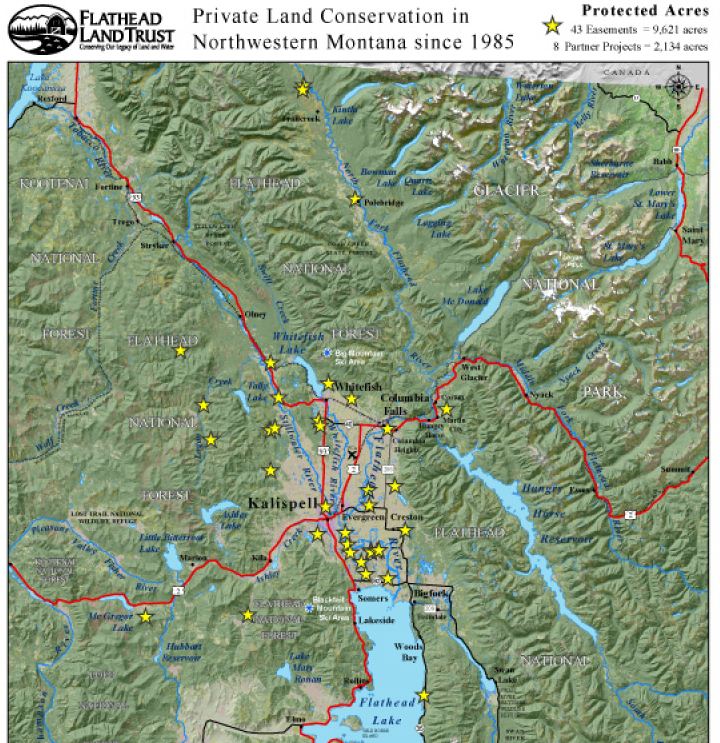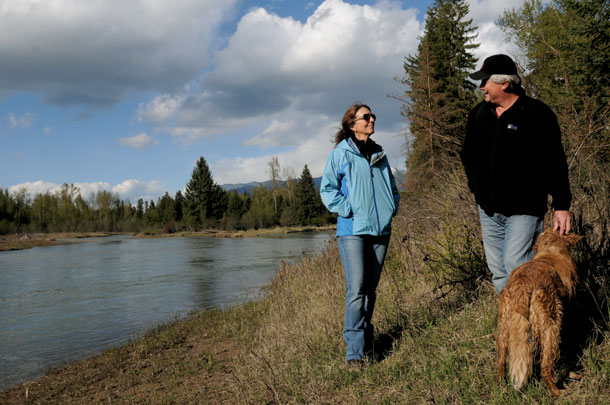Conservation Easements Gaining Ground in Montana
By: Amos S. Eno
Posted on:09/06/2012 Updated:09/24/2012How thousands of small-acreage conservation easements add up to landscape-scale environmental benefits
How thousands of small-acreage conservation easements add up to landscape-scale environmental benefits.
In ways big and small, Montana’s Flathead River watershed in the shadow of Glacier National Park is being protected.
Thanks to concerted efforts which began in 1958 with the founding of the Flathead Lakers, growing numbers of conservation organizations and partner agencies have contributed to conservation along the river corridor. As a result of the combined efforts of these various groups, conservation easements and other natural resources protection measures have been put in place to permanently protect:
-
41% of the 100-year floodplain,
-
58% of quality riparian areas that provide fish and wildlife habitat and filter pollutants from runoff,
-
51% of the wetlands,
-
43% of the areas overlying shallow groundwater,
-
29% of the banks along the Flathead River’s main channel, and,
-
34% of the corridor’s important agricultural soils.
Those percentages from the Flathead Valley’s River to Lake Initiative testify to the fact that much has been done in the past half century – and that much more work remains in a scenic area where development pressures have been intense.

The Flathead Land Trust map above shows that land trust’s easements. For a more detailed picture showing the full range of conservation efforts, see the River to Lake Initiative map.
Significantly, much has been done thanks to relatively small conservation easements, such as the 28 acres which Valerie Beebe donated last year to create a conservation easement near the Smith Lake Waterfowl Production Area. Similarly, the 97 acre riverside conservation easement which the Smith family finalized last year is small. But those acres are important for protecting the river, unspoiled wildlife habitat and pristine views. As well, the acres multiply. The Smith’s 97 acres follow the family’s 107 acre easement created in 2000 and a 163 acre easement which Eric Smith’s mother created four years earlier.
Kalispell, Montana realtor Eric Smith and his mortgage-broker wife Becca Hand-Smith are well aware of the full development value of their riverfront property. Nonetheless these two real estate professionals have ensured that their land remains working farmland forever. Eric explains that for a beautiful area which has become over-developed with summer and winter vacation homes, “it’s nice to conserve whatever part you can of this northwest corner of Montana.”
Eric says that with soaring land prices pressuring landowners to sell their land for development, he and his wife “feel it’s important to keep some of that land for farming and wildlife and open area.” So they put their land in a perpetual conservation easement “as a way to leave a legacy.” They’ve put two easements in place because after creating their first 107 acre easement, they bought an additional 97 acres when it came on the market, in order to preserve more land along the river.

Becca Hand-Smith and her husband Eric Smith stand on the bank of the Flathead River on a section of their property they recently donated as a conservation easement. Photo credit: Lido Vizzutti/Flathead Beacon
Adding to the overall conservation impact, Eric says one adjacent property already has a conservation easement on it and his northern neighbor is considering a conservation easement: “So we’re creating sort of a corridor along the Flathead River that is protected . . . My wife and I love the idea when we’re standing on the riverbank, looking across our property from the river, looking up at our home which sits up on a bluff above the bottomland, we love the idea that this is the way it’s going to be forever. Nobody’s ever going to change that.”
Working closely with landowners like the Smiths, the Flathead Land Trust had a record year in 2011, putting more than 500 acres in new conservation easements. This land protection success is part of a much larger picture. The Flathead Land Trust is one of 12 separate nonprofit land trust organizations which make up the Montana Association of Land Trusts (MALT). Since 1976, MALT has overseen the creation of over 1,000 conservation easements which today protect more than 2.1 million acres in Montana.
MALT member Montana Land Reliance (MLR) partnered with FLT to create the Smith’s 97 acre easement. MLR Western Manager Mark Schiltz explains that MLR works hard “to develop neighborhoods, trying to link conservation easements together in ways which multiply the environmental benefits.”
Flathead Land Trust (FLT) Executive Director Marilyn Wood explains that it’s well worth putting easements on even relatively small parcels because these include “some of the most critical habitat” and “We look to consolidate those areas.” She says FLT is working closely with landowners and with other conservation organizations like MLR to “link these smaller properties together.” She points out that “The Smith’s 97 acres is close to one of our easements that’s over 400 acres and it’s adjacent to another tract we’re working on right now that’s another 90 acres, so when you look at putting these pieces together, it’s a very significant conservation achievement.”
Drawing on the FLT board’s local knowledge, Wood says FLT seeks out landowners willing to consider conservation easements for their property: “When we approach landowners, it’s certainly their right to do whatever they want with their property. We just let them know there is an effort to protect this very special Flathead River area and that they could be part of this bigger vision if they choose to.”
 Sign In
Sign In
 Sign In
Sign In
